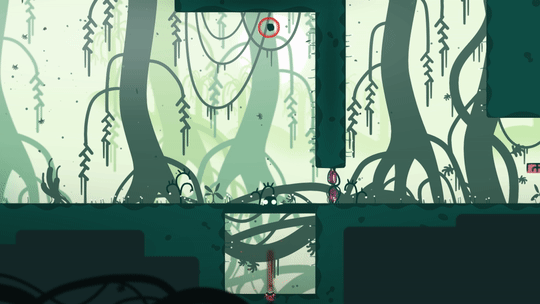
The video game Semblance by the South Africa-based Nyamakop studio has players reshaping a malleable digital world before it petrifies.
In most platform video games, players have to leap and tumble through a digital obstacle course of walls, barriers, and plunging cliffs, with progress made by overcoming this rigid terrain. However in Semblance, you are constantly redesigning the game’s topography. As a character named Squish — a purple blob with two glowing eyes — you bash into the walls and platforms to sculpt them like playdough into stairs, trampolines, and other new forms. You can even reshape yourself, all with the mission to keep this environment safe from the crystalline creatures that threaten its elasticity.
Semblance is not only a well-designed game which cleverly transforms the usual mechanics of a platformer, it’s the first game developed by an African studio to be released on a Nintendo platform. (In addition to Nintendo Switch, it’s available for PC and Mac.) It was created by Nyamakop, an independent studio founded by developers Ben Myres and Cukia “Sugar” Kimani in Braamfontein, South Africa.

“The game started life as our final year university project in 2015 at our game design course in Johannesburg, South Africa,” Myres told Hyperallergic. “The game was originally set inside an abstract Rothko painting where you could only change the character’s shape. We showed the game to our external examiner, who was a lead on the Uncharted and The Last of Us games. The first thing he said was ‘make this into a commercial game’ and so we did! We worked on it part-time since that point, and then in late 2016, we started work full-time on it.”
Not much of Rothko is left in the game — aside from a fairly minimal palette that shifts with each environment from swampy green to bright fuchsia. Yet it has a distinct aesthetic, from the atmospheric soundtrack to the layers of organic silhouettes that suggest simple but strange flora and fauna, which immerse players in this squishy world. In each of the levels, which are all accessible for you to bounce through from the beginning, you pick up a new skill, ultimately bringing them all together in the final stage. The goal is to collect a series of orbs that will eradicate an infection of hardness that is plaguing the soft biomes of Semblance, which, as its name suggests, is meant to be a place of changeable realities.
There’s no dialogue or much narrative, although there are some tantalizing questions such as why the invaders that are calcifying Semblance look so much like your character. While I did find the mechanics a little challenging at first — I launched my poor character into a pit a good 20 times before figuring out how to jump, the repetition of its tiny death shriek being rather upsetting — the game generously doesn’t erase your progress upon failure. You can leave the levels if you’re stuck, and return later, without losing your changes. This makes even its most complex puzzles satisfying, especially as they often have solutions that are elegant without being overly complicated. What I most enjoyed was that, whereas most platformers ask you to tackle an existing environment, in Semblance you are a sculptor, mashing and squashing your tiny character to mold its terrain. Everything is about reimagining what the world can be.

Game studios aren’t as concentrated in South Africa as many parts of the world, and getting international attention for their releases can take a lot of travel (like Nyamakop did in promoting Semblance).
Nevertheless there is an ever-growing development scene. The recent Electronic Gaming Expo in Cape Town featured several homegrown games, including Semblance, as well as the popular action hero side-scroller Broforce by Freelives, the physics-based puzzler Entangled by Mentaloop Games, and the multiplayer High Cats by Indie Glue in which you play as cats trying to catch a tuna can.
Johannesburg’s University of the Witwatersrand, where Myres and Kimani met, has the country’s first dedicated game design program, while annual events like the A MAZE festival bring together artists, developers, and digital activists to collaborate on workshops and a games arcade.
“It’s incredibly important for Africans to see themselves in games, and for Africans to be making games, too,” Myres stated, citing examples like the 2016 Aurion: Legacy of the Kori-Odan, a role-playing game based on African mythology developed by Kiro’o Games in Cameroon, and Rangi, a 2017 VR puzzler designed by Funsoft in Casablanca that was inspired by African culture. He added, “It’s not even just for Africa looking in, but also there are things the rest of the world can learn from Africa.”
By Allison Meier - Source of article Hyperallergic

Aucun commentaire:
Enregistrer un commentaire